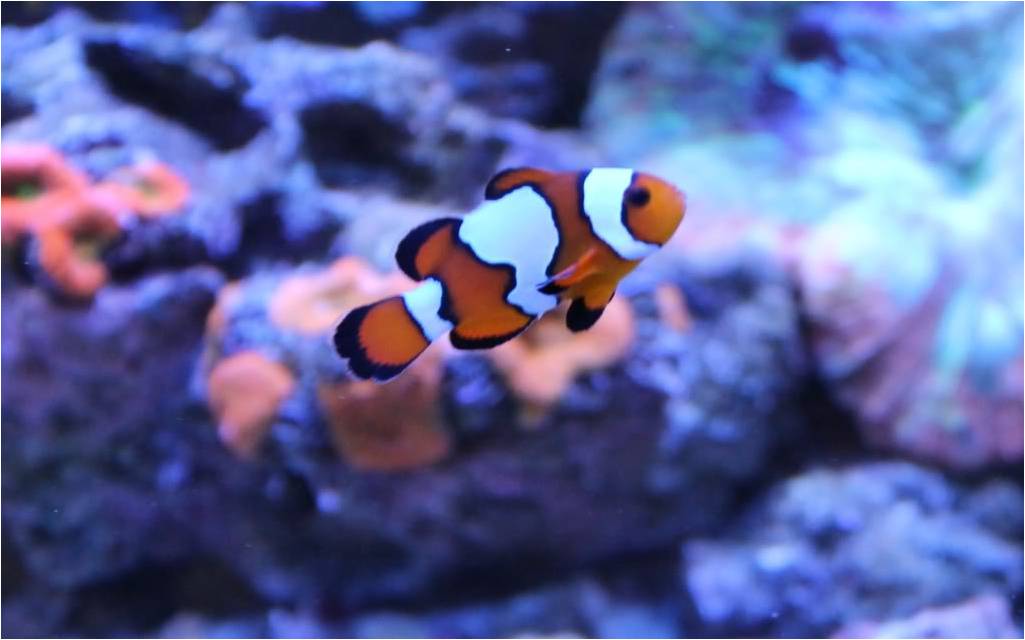
Good Starter Fish and Clean-up Crew Options
So, now after deciding to set-up your first marine aquarium and having your patients tested to the limit waiting for your tank to become cycled, you are now ready to add your first inhabitants.
Wither you decide to start off by adding your first fish or two, or start by adding your clean-up crew (CUC), can really depend a lot on your personal preferences and potentially any algae you would need to start controlling.
Your First Fish
Not all marine fish are suited for new set-ups. Some marine fish are very hardy as compared to others. The selection of the first few fish for your new aquarium is even more important for a hobbyist that is new to marine aquariums. It is important to make sure the first few marine fish you choose are not only very hardy, but can also be very forgiving to the typical mistakes common to beginners.
The below are a few fish that I have found to be very hardly. Whatever fish you decide to start with, you also have to be very mindful to potential compatibility issues with other fish and/or corals you may want to add in the future as well as the fully grown adult size of the fish in relation to the size of your tank. Most fish sold at local fish/pet stores are younger fish that are nowhere near their potential fully grown sizes.
As with all marine fish there are two things that I look for when selecting a fish. The first is tank bred fish. These are fish that are born and raised in an aquarium which makes them better suited to life in your aquarium as well as helping to limit the harvesting of fish from the ocean. Where tank bred fish are not practical, I will then look for MAC (Marine Aquarium Council) certified fish. The MAC is a voluntary organization which governs the collection practices of wild caught fish to help manage/maintain the populations along with the most human collection and handling practices when collecting fish for re-sale in the hobby.
The information in the below link can also help you assess the over health and condition of a fish before taking them home.
https://reefaquarium.com/2012/picking-out-new-fish-for-a-new-marine-aquarium/
Below are some hardy fish which can be a better suited for new tanks and/or new hobbyists.
Fox Face
There are few different types of fox face such as: Magnificent Fox Face (Siganus Maginficus), Fox Face Lo (Siganus Vulpinus) and the One Spot Fox Face (Siganus Unimaculatus) just to name three of them. Although these fish are very hardly, they can also get around 7 to 9 inches in length and will require a larger aquarium to accommodate their size. Fox face are great community fish, one of the few marine fish that have been known not to become aggressive towards other fox face fish in the same tank with them. These peaceful fish can also become a good part of your clean-up crew as they like to pick at green algae throughout the day. My fox face will spend his day swimming around the tank picking at the rocks paying no attention to any other fish in the tank. Minimum tank size for one of these fish would be a 75 gallon tank
The below picture is of my Magnificent fox face. He was still very young in the below picture and only 3 to 4 inches in length
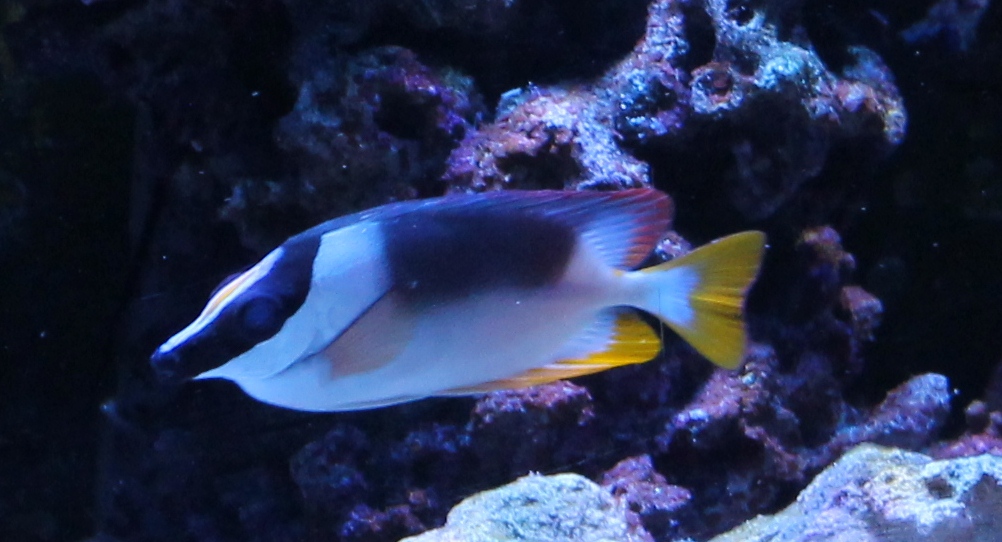
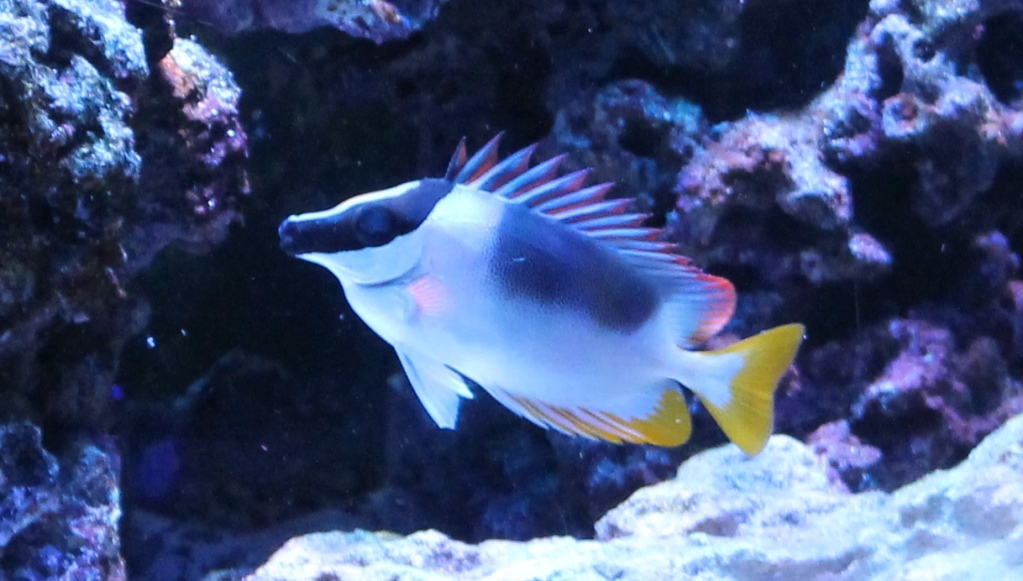
Clownfish
Just as with the fox face, there are many different types of clown fish, but not all clown fish are suited for new tanks or new hobbyists. Some of better suited clownfish for a new community tank and are more commonly available would include: Ocellaris Clownfish (Amphiprion ocellaris), Black Oscellaris Clownfish (Amphiprion ocellaris var) , and True Percula Clownfish (Amphiprion percula). There are a few more but these three seem to be the most commonly available ones in most fish stores.
These fish are among the most popular fish for beginners and advanced hobbyists alike. They are very hardy and its somewhat easy to find tank bred clownfish. They will do well by themselves or in a pair. If you want a pair of clown fish, then it is best to add them at a very young age, or ensure that one is noticeably larger than the other one. The reason for this is to allow one fish to assume the dominate role with less stress between the two clown fish. It is not recommended to have more than one pair of clownfish in a tank, unless that tank is very large. When kept in very good conditions, it is very common for clown fish to breed in your aquarium. Depending on the type of clownfish you get, you can expect their maximum size to reach around 4 inches. This too can vary depending on the exact type of clownfish you get.
It is very common in the wild to find clownfish hosting in an anemone for a form of natural protection and shelter. However, in a home aquarium without any of the clown fish’s natural predators, the clown fish do not need the protection of an anemone and will be perfectly fine without one. Anemones are not suggested for beginners as some of them can be difficult to keep unless you are experianced keeping anemones. As it is natural instinct for clown fish to host, they have been known to host in corals when there is no anemone to be found. Do not mistake this behavior as a response to a need for an anemone.
Some would say the minimum tank size for clown fish would be a 20 gallon tank, but I would suggest a 29 gallon tank.
Note: maroon and cinnamon clownfish should be avoided unless you have experience with them. These fish can be very aggressive and problematic for the other fish in your tank. They also have slightly different requirements than normal clown fish have.
Below are a few pictures of my black oscellaris clownfish and snowflake clownfish

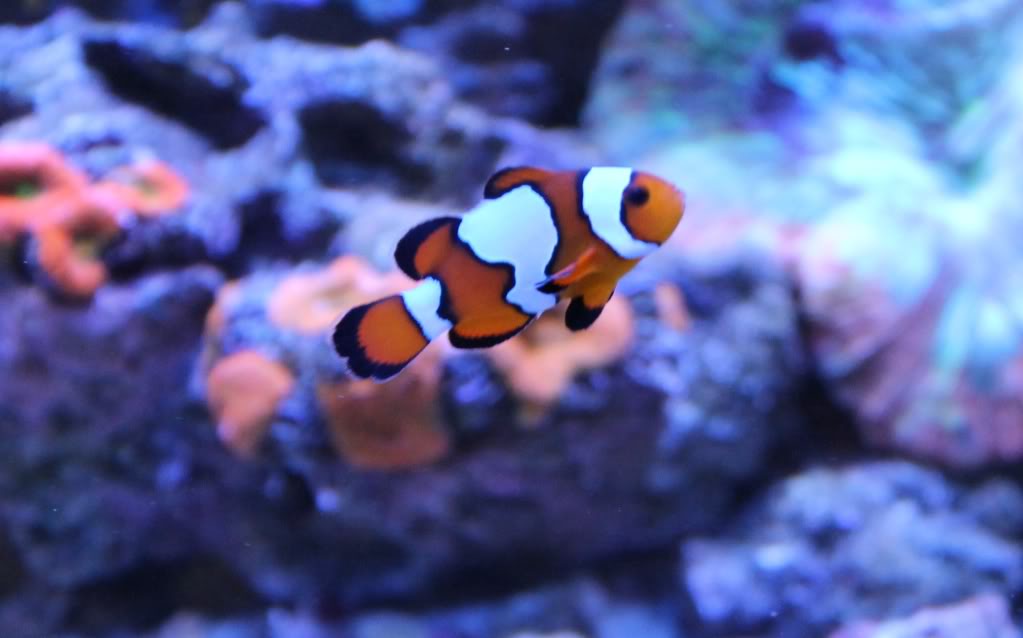
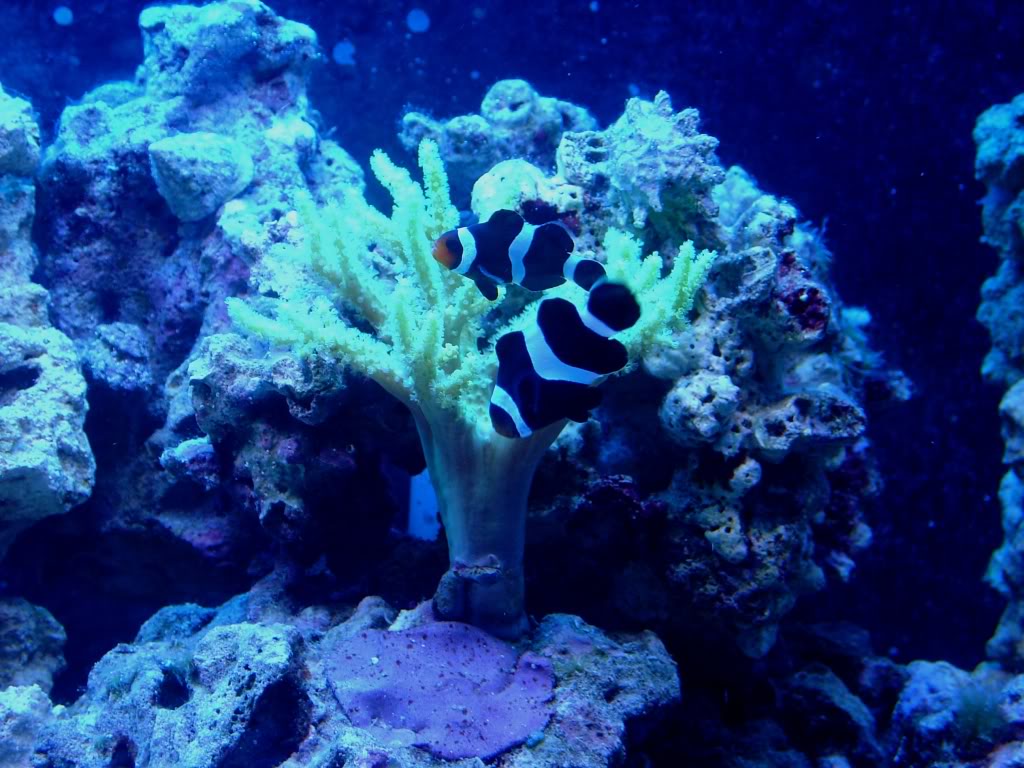
Banggai Cardinal (Pterapogon kauderni)
These are very interesting looking fish to say the least. They will reach a maximum size of around 3 inches (closer to 5 when you include that long tail fin). They are very hardy and are best when kept as a single fish or as a mated pair. Banggai cardinals are also easy to breed in captivity making it easy to find tank bred fish. These fish are extremely hard to sex so getting a matted pair can be challenging at times. If you do get a mated pair and you are keeping them in very good conditions, they will spawn in your tank before you know it. Mine spawn about every 4 weeks or so. There are more and more tank bred Banggai cardnels becoming available for sale.
Other would recommend the minimum tank size for banggai cardinals would be a 29 gallon tank, but I would suggest something closer to a 36 inch long 35 gallon tank.
The below picture is of one of my Banggai cardinals
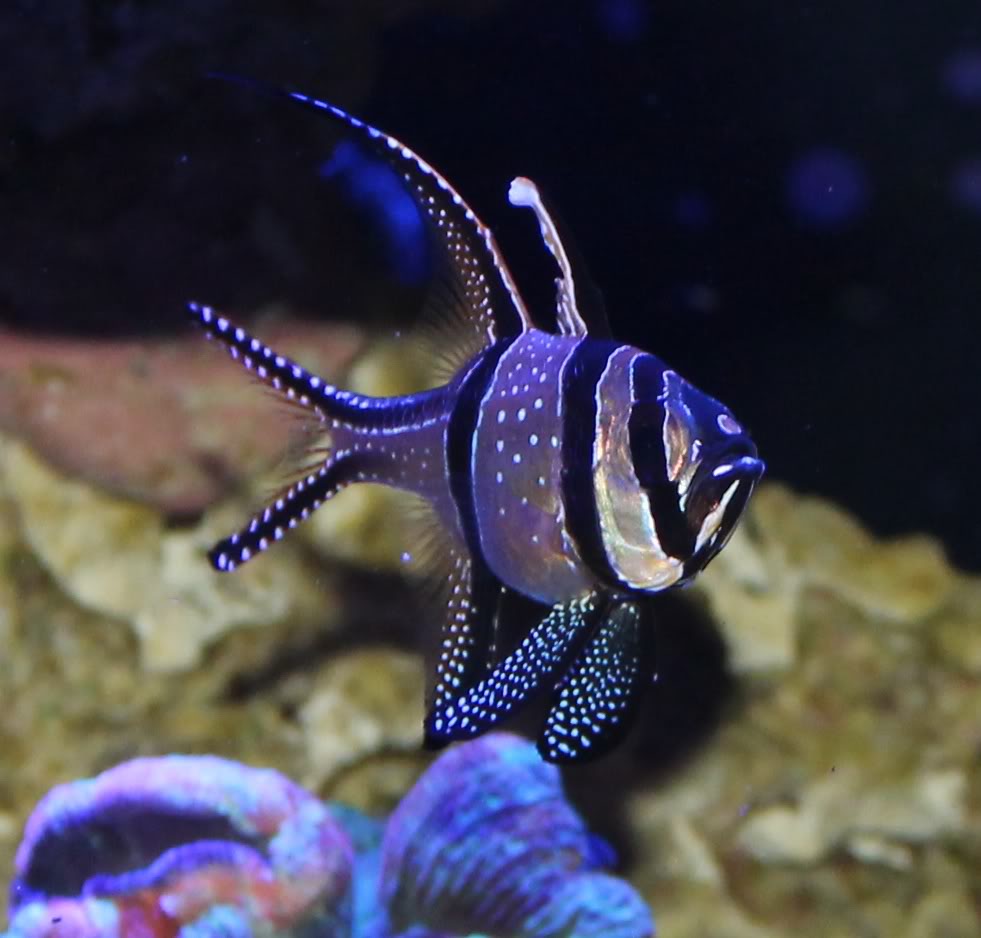
FireFish
This includes the Red Firefish (Nemateleotris magnifica), and the Purple Firefish (Nemateleotris decora) These are another colorful and hardy fish very well suited for a beginner. They stay fairly small (around 3 inches) making them suited for a wider range of aquarium sizes. Just as with the Banggai cardinals, they are best kept as a mated pair or as a single fish. They will typically hide in the rocks when they do not feel comfortable. Fire fish have also have been known to be jumpers when spooked so they are not recommended for open top tanks.
Minimum tank size for firefish would be a 20 gallon tank, but I would suggest nothing smaller than a 29 gallon.
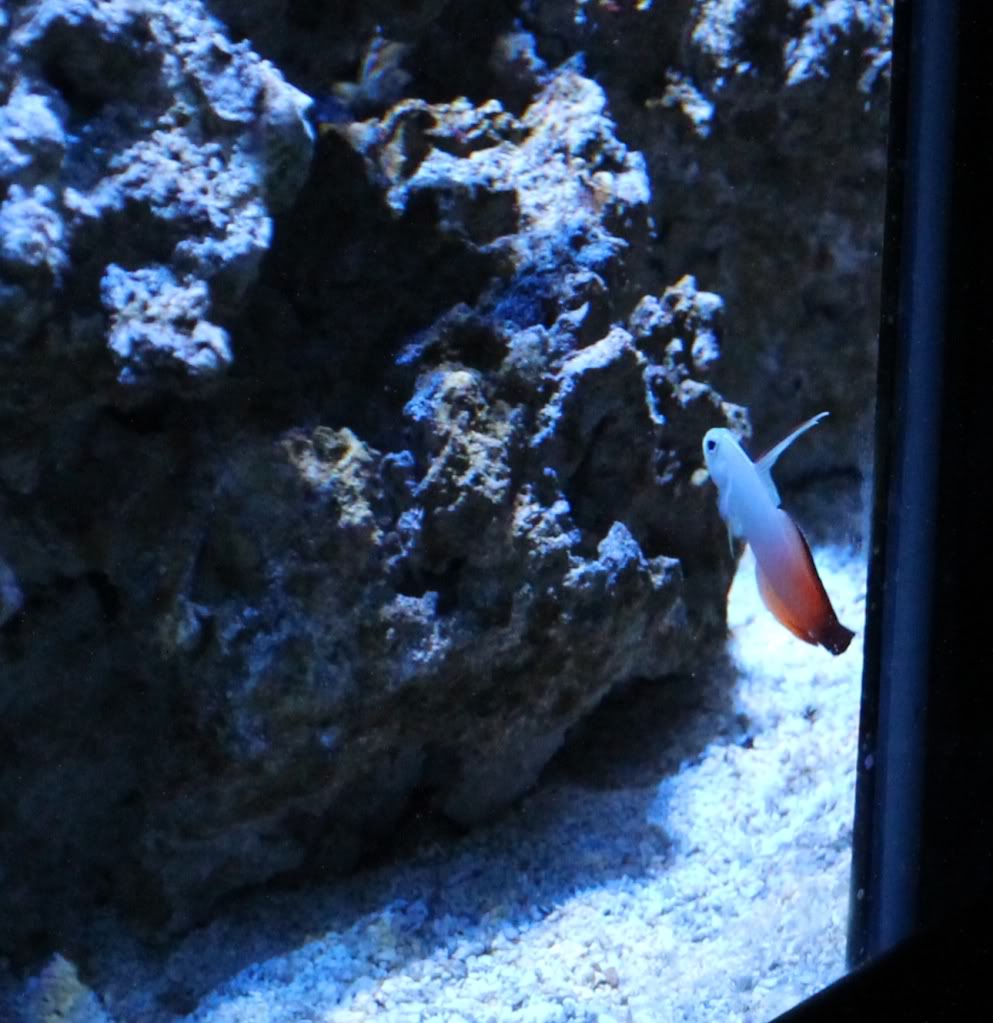
Zebra Barred Dartfish (Ptereleotris zebra)
This is another hardy fish to consider. These guys are a very close cousin to the fire fish. The biggest difference is that dart fish are a schooling fish and should be kept in numbers of 6 or more. My zebra dart fish seam to do best when kept in numbers of 8 or more. These fish are not recommended for open top tanks as if they get spooked, they have been known to jump. They will stay on the smaller side reaching a maximum size of around 3 to 4 inches. The below pictures are of my dart fish. These are active little fish and very hard to get a good picture.
You will find a lot of different opinions on the minimum tank size for these fish. As these can be very active and schooling fish, I would suggest the minimum tank size would be a 48 inch long tank of no less than 40 gallons.
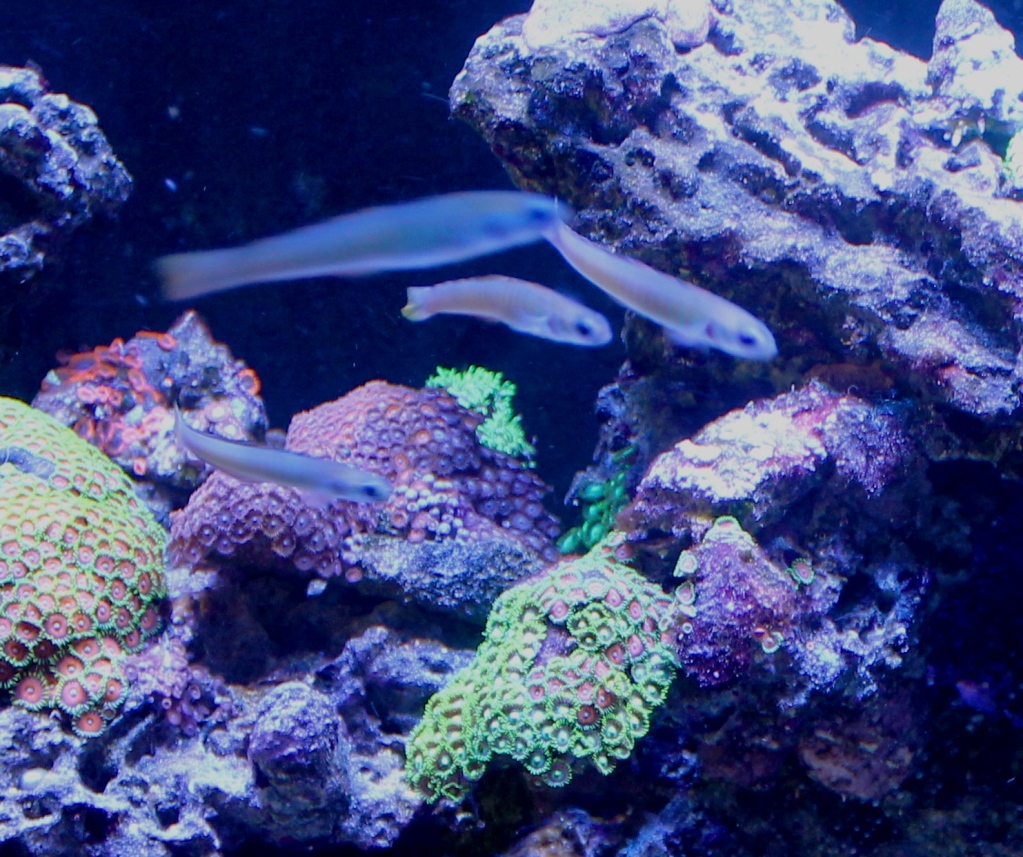
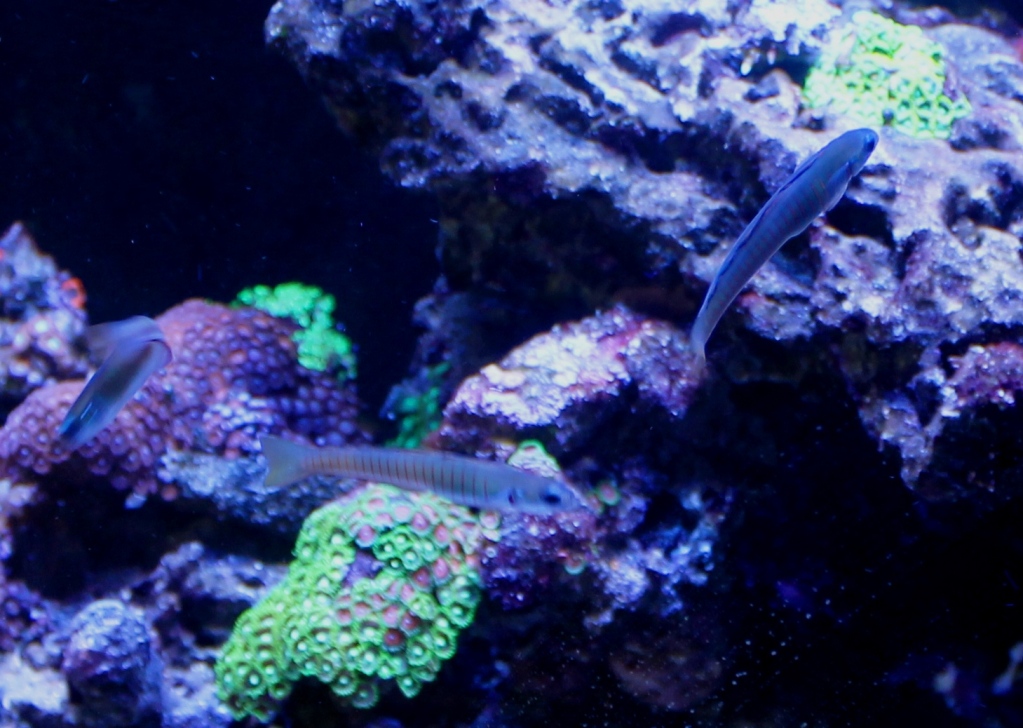
Blennys
There are a few different types of blennys to consider. This list would include: Starry Blenny (Salarias ramosus), Midas Blenny (Ecsenius midas), and the Bicolor Blenny (Ecsenius bicolor). Not only are these fish hardly, but they have a lot of personality making them a highly entertaining fish to watch. Maximum size is around 4 to 5 inches depending on the exact type of blenny. Most blennies also like to perch on a rock or squeeze into a tight space and watch what is going on around them.
You will find a lot of different opinions on minimum tank size for these fish. I would suggest the minimum tanks size for a blenny is a 36 inch long tank of 35 gallons (or more).
The below picture is of my starry blenny
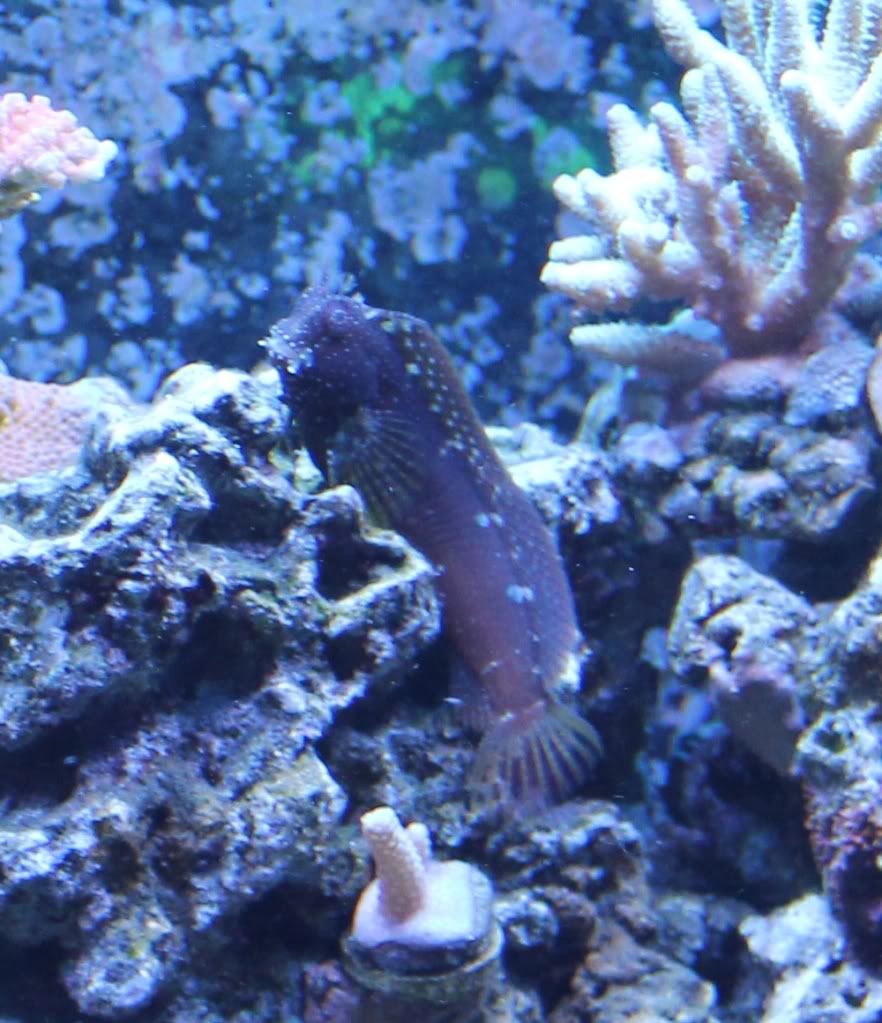
Wrasses
There also are a few different types of wrasses to consider. This list would include wrasses such as: the Orange back fairy wrasse(Cirrhilabrus aurantidorsalis), Carpenters Flasher Wrasse (Paracheilinus carpenteri), Red Velvet Fairy Wrasse (Cirrhilabrus rubrisquamis), and the Six Line Wrasse (Pseudocheilinus hexataenia). In my opinion, wrasses have some of the nicest colors of all the more hardy marine fish. Wrasses can get from 3 to 4 inches in size (depending on the exact type). They are full of personality and a good community fish. The below pictures are of my orange back fairy wrasse and six line wrasse.
I have a different opinion on the minimum tank size than most other others have. The minimum tank size for a six line wrasse should be a 29 gallon. For the larger wrasses, I would suggest a larger tank of 55 gallons or more.
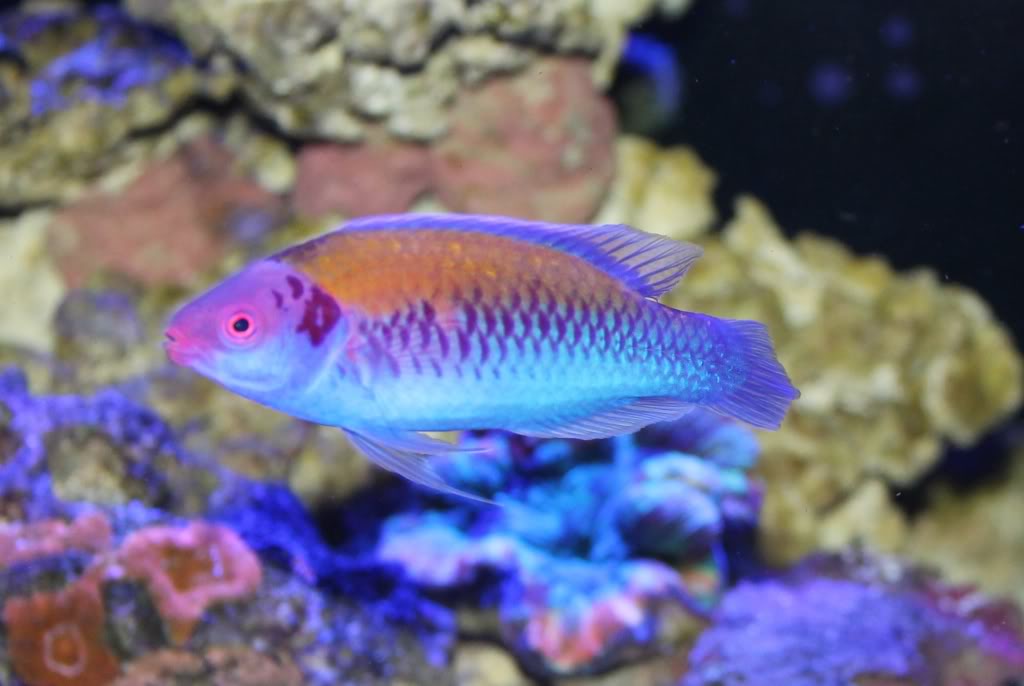
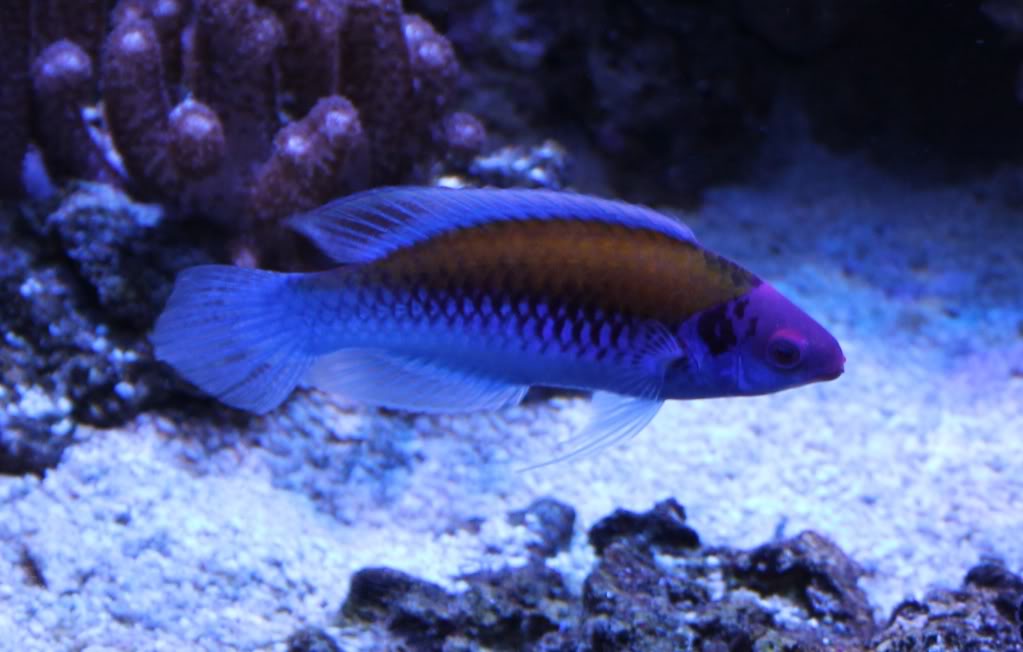
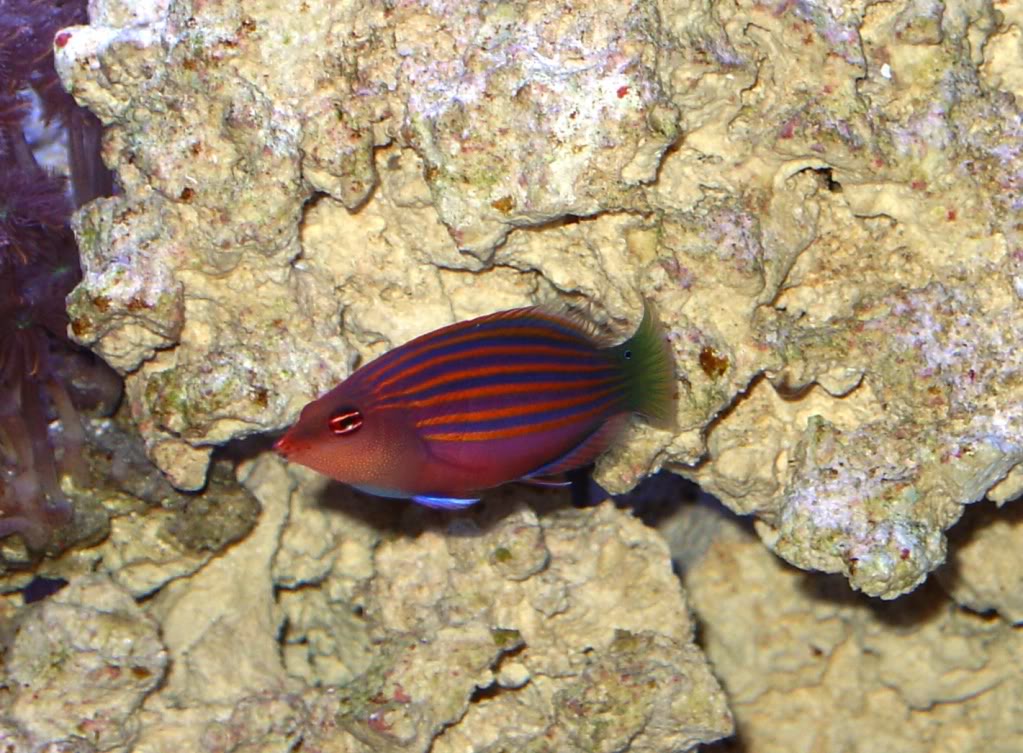
There are other fish that are also recommended for beginners such as: Royal Gramma (Gramma Loreto), Orchid Dottyback (Fridmani pseudochromis), and many of Chromis including the Blue/green Chromis (Chromis viridis). I cannot offer much insight into these fish as I have never kept any of them. I would encourage you to do your own research before getting any one of these fish or any of the other fish described here.
Why Have I Not Mentioned Damsels ??
Damsels just might be one of the hardiest marine fish available in the hobby. Before the use of live rock and fishless cycling processes became mainstream in the hobby, a few types of damsels were commonly used to cycle marine tanks. Unfortunately, damsels can become aggressive enough to kill their tank-mates. I have seen this first hand in a friend’s tank. The reason for this is that most of the damsels will become highly territorial, and when they choose an area of the tank as theirs, all the other fish that swim by are in trouble. This can even happen with the damsels that are said to be less aggressive such as the yellow tailed damsel (Chrysiptera parasema). For those reasons, I would recommend avoiding any type of damsel in your tank unless you are experienced with them or experienced managing aggression in fish.
The below link will give you a list of other marine fish you should avoid for your first set-up
http://www.aquaticcommunity.com/aquariumforum/showthread.php?t=28508
Your First Clean-up Crew
The term Clean-Up Crew (CUC) is used as a generic definition used to describe the smaller critters in your aquarium that will take care of (ie.. clean-up) uneaten food, debris, and many different types of algae. This mostly includes snails and crabs, but can also include shrimp and fish. The below list shows some of the more common and easier to keep CUC options. They can make very good first additions to your set-up.
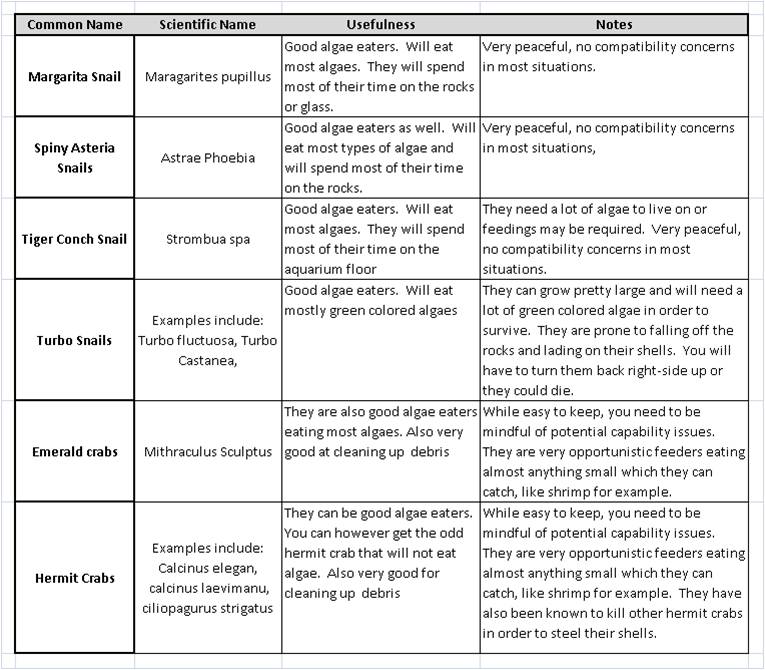
If you have any questions about this article, please start a thread in our forum. If you are not a member, signing up is easy and will only take a minute of your time.
http://www.aquaticcommunity.com/aquariumforum/forumdisplay.php?f=62
Great article, you picked out some good looking fish.
yea, doesnt sound like a good diea.Just like frtewhaser, the larger the tank, the easier it will be.A small saltwater tank needs alot of maintance because the water parameters will change so frequently. Adding some frtewhaser to a 10 gallon will change the salinity drastically where as the in a larger tank, it wont affect it that much.Yea a 10 gallon nano with two clownfish looks attractive, but it is hard to maintain and if you havent worked with saltwater before, it is going to be that much harder.
Good post
sorry to say but not going to work bc it the tank is to small. I would recommened 35gallon + for a sattwaler tank. It would casue to much trouble and problems doing it with a 10gallon. I suggest getting a bigger tank to start a salt water tank. And putting 10pounds of live rock, in a 10 gallon tank would take up mos tof the same. Highly recommed you do not.
Those are some good points. The smallest tank size that I would suggest for any marine aquarium would be a 29 gallon tank. If you are setting up your first marine tank, something larger, like a 55 or 75 gallon tank would be a lot better.
Why does everyone try to say that a nano tank will not work? I have a 15 gallon tank that Is up and running with my 2 oscellaris clownfish, 4 Red Foot Hermit Crabs, and 1 Turbo Snail. I have 15 pounds of live sand and 16.5 pounds of live rock right now and my tank Is striving. Keep in mind It’s a 15 gallon column tank so It’s tall. The bigger the tank more expensive it is to set up due to water changes being so many gallons and the proper lighting to house corals. To each is own. I love my nano tank!!!!!!! Best advice I can give is “DO YOUR RESEARCH”.
Jason: no one has said that it will not work, just that it is not a good idea. A 15 gallon marine can certainly be made to work when properly set-up and stocked correctly, but you really have to do your home-work (as you have stated) and keep a closer eye on things. Sometimes it can be a a trade off between cost and effort. A 15 gallon tall is not the best size of tank for two clown fish and will likely not work very well long term.
Man all the Nano haters! Why is it not a good idea? Because it will be too much work?! My first saltwater tank was a 2.5 gallon reef tank. It was awesome! It just had a bunch of mushrooms and zoas and one little peppermint shrimp. I loved it and will go back to one for my kitchen counter when the kids are bigger. I loved being able to see things crop out of my 2.5 gallon that I would have missed in a bigger tank. The biggest reef tank I have had was a 40 gallon breeder tank. I did my research and enjoyed my efforts. Do not let anyone tell you not to go small.
Cindy: No one is hating Nano tanks here. Just stating that it is easier to keep a larger tank stable as compared to smaller ones. This can be more of a challenge when you have both fish and corals.